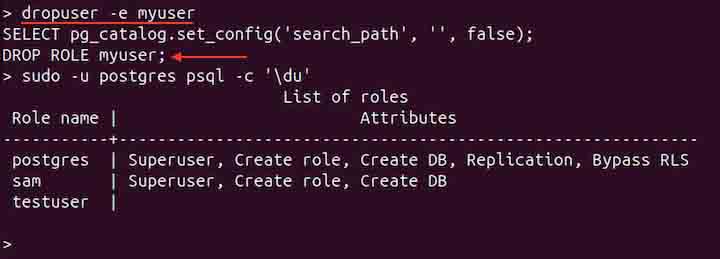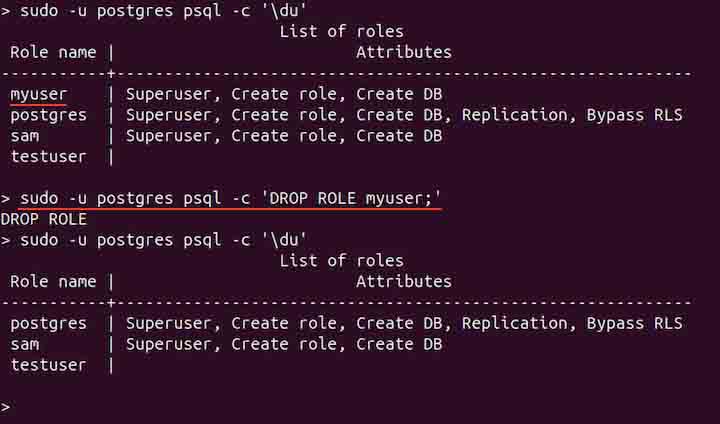
- Unix Commands Reference
- Unix Commands - Home
dropuser Command in Linux
The dropuser command removes a PostgreSQL user account in Linux. A superuser or a user with admin privileges can remove a user account using this command. The dropuser is a wrapper command of DROP ROLE, and using either will achieve the same task.
The removal of a role simplifies user management and reduces security risks. Moreover, it helps in managing resources efficiently.
Table of Contents
Here is a comprehensive guide to the options available with the dropuser command −
- Prerequisites of using the dropuser Command
- Syntax of the dropuser Command
- dropuser Command Options
- Examples of dropuser Command in Linux
- Removing a Postgres User using DROP ROLE Command
Prerequisites of using the dropuser Command
The dropuser command primarily removes the PostgreSQL user account. Therefore, ensure that PostgreSQL is installed and configured in Linux. To check whether PostgreSQL is installed or not, use −
psql --version

If it shows a version, then it means that PostgreSQL is installed. If it prints an error, then install and setup PostgreSQL.
Syntax of the dropuser Command
The syntax of the dropuser command is as follows −
dropuser [options] [username]
To specify the connection and other arguments, the [options] field is used. The [username] is the name of the user account that needs to be removed.
dropuser Command Options
The options of the dropuser command are listed in the table below −
| Flags | Options | Description |
|---|---|---|
| -e | --echo | It displays the commands that the dropuser sends to the server |
| -i | --interactive | It displays the confirmation prompts |
| --if-exists | It displays a notice that the user does not exist instead of throwing an error | |
| -V | --version | It displays the dropuser command version |
| -? | --help | It displays a brief help of dropuser command |
The connection options are given below −
| Options | Description |
|---|---|
| -h (--host=) hostname | To specify the hostname on which server is running |
| -p (--port=) port | To specify the port number or Unix domain socket on which the server is listening |
| -U (--username=) username | To specify the username to connect as |
| -w (--no-password) | To prevent the password prompt |
| -W (--password) | To force for the password prompt (dropuser automatically prompts for the password if server demands) |
Examples of dropuser Command in Linux
This section demonstrates the use of the PostgreSQL dropuser command in Linux −
- Removing a Postgres User Account
- Removing a Postgres User Interactively
- Displaying a Notice if a User does not Exist
Removing a Postgres User Account
To remove a Postgres user account, first identify the user by listing all users. To list the Postgres users, use the command given below −
sudo -u postgres psql -c '\du'
Here, postgres is the default PostgreSQL user; change it according to your requirement

The output shows different users.
To remove the user myuser, use the command given below −
dropuser myuser
To display the commands the dropuser sends to the server, use the -e or --echo commands −
dropuser -e myuser
To verify, list the users again using the command given above −

Removing a Postgres User Interactively
To remove a user interactively, use the -i or --interactive options −
dropuser -e -i myuser

Displaying a Notice if a User does not Exist
To display a notice if a specified user does not exist, use −
dropuser --if-exists myuser

Display Help of the dropuser Command
To print quick help about the dropuser command, use the -? or --help option −
dropuser --help
Removing a Postgres User using DROP ROLE Command
The DROP ROLE command can also be used to remove a Postgres user. Use the following command to remove the Postgres user −
sudo -u postgres psql -c 'DROP ROLE myuser;'

Conclusion
The dropuser command in Linux removes a Postgres user account. It is a useful command line utility for managing Postgres users. Removing unnecessary users helps in resource management. The dropuser is a wrapper of the DROP ROLE command, therefore, the user can also be removed using it.
In this tutorial, we explained the dropuser command, its syntax, options, and usage through various examples.